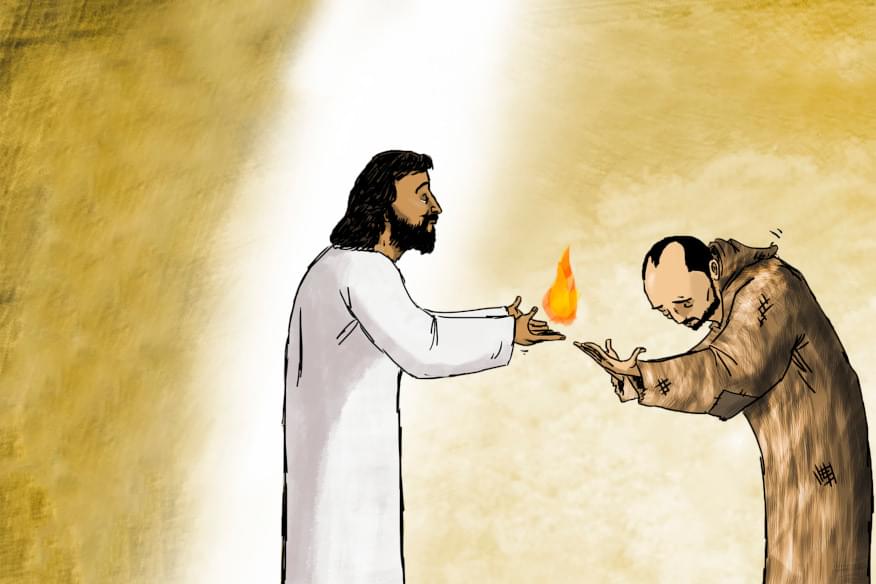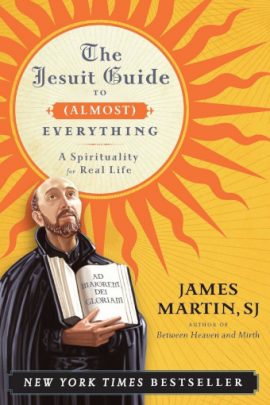A Pilgrim's Journey
Ignatius of Loyola
At the age of 30, Ignatius was a knight of the Royal Court of Spain. Success, fame and honors were the values of his life. Then, during the siege of Pamplona, a cannonball seriously injured his leg. He underwent two surgeries followed by a long convalescence that forced him to put his life in order and, with a new outlook, walk along new paths.
The birth house
Iñigo López is born in the tower house of Loyola, in the municipal district of Azpeitia, in the Basque province of Guipúzcoa. The last of thirteen children, he belongs to an aristocratic family: his father, Beltrán Ibañez de Oñaz, fights on the side of the Catholic Kings in the war of succession to the Castilian throne, while his mother, Marina Sánchez de Licona, descends from an important noble family of the city of Ondárroa. The environment in which he lives is marked by courtly values, loyalty to the Crown and the desire for power, ambition and success.
Secular career
Iñigo loses his parents and is transferred to Arévalo, in the retinue of King Fernando the Catholic’s Minister of Finance, Juan Velázquez de Cuéllar, who tries to impart to him a knightly and religious education aimed at “distinguishing himself” and accomplishing great deeds. He is soon known by the people of Araévalo for his ability to play the vihuela, his boldness in knightly tournaments and his agility in dances and festivals. The arts, war, and agons are his daily bread; glory, power, and appearance the values to which he gives his life.
A new beginning
On May 20, he proves his determination and ability by defending the castle of Pamplona besieged by French troops. During the battle a cannon ball seriously wounds his legs, “breaking one in several places and badly injuring the other. When he was defeated, those in the fortress immediately surrendered to the French”. In his mind, the wound to his legs, with the risk of being paralyzed, and the defeat of the fortress become the failure of his world and perhaps also of his pride, which remains deeply affected.
Convalescent in Loyola
On June 29, he improves. He gets back on his feet. There remains a deformity in his leg, which prevents him from putting on his boot. He decides to have surgery. A difficult and painful intervention. He resists, silent. Afterwards, he asks to read novels of knighthood. There are only the Vita Christi, by the Carthusian monk Ludolf of Saxony, and a translation of the Golden Legend on the Life of Saints, by Giacomo da Varazze. He becomes fascinated by the person of Jesus and those who followed him. The conversion begins, the attention to what he experienced in his heart: consolations and desolations.
The vision at the Cardoner
On March 25, from Montserrat he goes to Manresa where he leads a life of prayer and penance for more than a year. It is a time of consolations and deep desolations. His past life never ceases to torment him, as do the thousand scruples about the present. His way of living, with frequent fasting and penances, weakens his body and spirit, so much so that he even contemplates suicide. But Ignatius, the name he takes after the “vigil of arms”, also has mystical moments of spiritual uplift. In Manresa, near the river Cardoner, “he receives a great enlightenment”.
Insight of the Exercises in Manresa
He experiences that his heart is visited by deceits and by God. He realizes that discernment is the ability to understand joy and sadness, the difference between pleasure and joy, positive and negative sadness, authentic joy and its imitations. For Ignatius, it is the inner universe that gives strength and direction to our actions. This law of freedom, in every man who seeks the truth, is given to Ignatius for the service of the Church with the writing of the Spiritual Exercises, a booklet to be experienced rather than read, to redefine life and find freedom in choices.
The vigil of Montserrat
After recovering, Iñigo changes. He becomes a pilgrim. He leaves his money to restore an image of Mary and pay off debts. He takes leave of his servants. He begins a journey of spoliation. In February 1522 he passes through Aranzazu, a shrine near Loyola, and spends the night in prayer. He heads to the Benedictine abbey of Montserrat, near Barcelona. On the night of the eve of the Annunciation, a “vigil of arms”: he lays down his sword and dagger at the altar of Our Lady. He gives his clothes to a poor man and dresses as a pilgrim.
Pilgrim to Jerusalem
He wishes to reach Jerusalem. In 1523 he sails from Barcelona to Gaeta. He arrives in Rome where he meets, during the Holy Week, Pope Adrian VI, who blesses his journey. He goes to Venice and sails to the Holy Land, giving first to the poor what he had. He visits the Holy Sepulchre, Bethany, Bethlehem, the Jordan and the Garden of Olives. He would like to stay, but must give up. The Superior of the Franciscans, custodian of the Holy Land, forbids him to do so. He reluctantly accepts, recognizing God’s will for him, which is expressed through the Church.
The Inquisition in Alcalá and Salamanca
In 1524 he sails for Venice and, due to the plague, continues on to Spain. In Barcelona he studies Latin grammar and engages in spiritual conversations. He moves to Alcalá, university town near Madrid. He begins to give the Spiritual Exercises. Falls into the Inquisition’s net. Imprisoned for 17 days, he is instructed not to speak of the things of God without having studied. In 1527 in Salamanca, questioned by the Dominicans of St. Stephen’s Convent, he is imprisoned for almost a month and released with the obligation not to preach until he has completed his studies.
Studies in Paris
Ignatius realizes that he must deepen his studies in order to better serve the Lord. He sets out alone and on foot for Paris. He arrives on February 2, 1528 and remains there seven years. He must find money to support himself and experiences the humility of having to stay among the desks of the Sorbonne school, now at a certain age. He begins to suffer from severe stomach aches. He takes theology classes and obtains the master’s in artibus degree.
The first companions
He meets some students who, after the Spiritual Exercises and the experience of the Lord, decide to offer their lives as “companions of Jesus”. An international group: 5 Spanish, 4 French and 1 Portuguese, students at the Sorbonne. On August 15, 1534, in the chapel of Saint-Denis in Montmartre, Ignatius, Peter Favre, Francis Xavier, Nicolas Bobadilla, James Laínez, Alfonso Salmerón, and Simon Rodrigues profess vows of chastity and obedience and leave for the Holy Land to proclaim the Gospel or, on the Pope’s instructions, to go wherever they were needed.
The return to Spain
The companions agree that Ignatius would return to Spain to cure his stomach ache and resolve issues they had pending. Fr. Polanco and Fr. Araoz add that Ignatius also wanted to make amends for the bad example set in his youth. He proceeds to Pamplona and Almazzano, the village of Fr. Laínez. Then in Toledo he visits the parents of Salmerón. Finally he is in Valencia and sails for Italy, although the seas were infested by Barbarossa, a pirate of Suleiman II. From Genoa he heads to Bologna, then to Venice, where he meets his companions to sail for Jerusalem.
The disappointment in Venice
On April 27, 1537, the Pope gives the group permission to go to the Holy Land and on the same day the Sacred Penitentiary gives permission to the Jesuits to establish a priestly body. The political situation was very unstable and the conflicting relations between the Venetians and the Turks did not allow any ship to set sail. Ignatius and his companions decide to wait a year and in the meantime they divide themselves in various neighboring cities praying and living as the poor.
The vision of La Storta
Unable to leave for the Holy Land, in order to keep the promise made in the chapel of Saint-Denis, the Jesuits return to Rome, in groups of 2, to make themselves available to the Pope. Ignatius, at the outskirts of Rome, has an extraordinary mystical experience, the vision of “La Storta” in which “he saw so clearly that God the Father placed him with Christ, his Son”. The experience confirms him in his surrender to God’s will. The Lord completes Cardoner’s experience, in Manresa, and makes Ignatius understand that the Society is willed by the Lord himself.
The first Formula of the Institute
The Formula Instituti of 1539 constitutes the legislative core of the Society of Jesus. Expressed in juridical and curial language, it describes the spiritual experience of Ignatius and his first companions. Francis Xavier reports: “Among the many graces…to have seen…the confirmation of our rule and way of life.” A number of principles are expressed in the Formula, including the willingness to teach catechism to children and a special vow, in addition to those of poverty and chastity: obedience to the Pope, with which the Jesuits accept his every mission.
The Bull “Regimini militantis ecclesiae”
On September 27, 1540 Pope Paul III officially approves, with the Bull Regimini militantis Ecclesiae, the foundation of the Society of Jesus. With it he confirms the main characteristics, such as the title of “Society of Jesus”, the universal apostolate and the vow of a particular obedience to the Pope. It is said that, having read the Constitutions, he exclaimed: “Digitus Dei est hic”, “Here is the hand of God”. The document, which orders the life of the Jesuits, is written between 1539 and 1556, and stems from the spiritual and life experience of Ignatius and his first companions.
The election of Ignatius as Superior General
With the approval of the Pope, the Society must elect its own Superior (Provost General): the election takes place on April 2, 1541. Everyone elects Ignatius. Only he indicates, on his own card, to give his vote to the one who would have the greatest number of votes, except for his own name. A new election, on April 13, gives the same result. Ignatius retires to the convent of San Pietro in Montorio. There, the Franciscan Friar Theodore of Lodi, who receives his confession, orders him to accept and Ignatius agrees.
The Society of Jesus’ confirmation
In Rome, the Society of Jesus (Societas Jesu) establishes itself at the Church of Santa Maria degli Astalli: Francis Xavier leaves for the Indies and Japan while Ignatius and his companions begin to teach catechism, preach, found social and charitable works, such as the Casa di Santa Marta, which welcomes former prostitutes, or take care of orphanages and assistance to the poor. In 1550 Pope Julius III confirms the Order with the brief “Exposcit debitum”. The Society begins to operate in the center of Rome, “seeking God in all things”.
The narration of the autobiography
In the last years of his life, Ignatius, after several requests from his companions, decides to recount in writing how the Lord had guided him from the beginning of his conversion until the foundation of the Society. It is “The Pilgrim’s Account” or “Autobiography”, since Ignatius himself, in the third person, narrates the events, a true spiritual testament. Ignatius tells the “story” of God in a soul to which corresponds the “story” of the collaboration of a man, Ignatius, intent on the continuous search for His will.
Ignatius’ death
Ignatius suffers from a severe gallbladder disease. On the evening of July 30, 1556, he senses that he is about to die. He wishes for a blessing from the Pope, but his secretary, Juan de Polanco, postpones it until the morning. Around midnight, one of his confreres hears him praying: “O my God”. Ignatius dies, without the anointing of the sick, on the morning of July 31, at the age of 65. Buried on August 1 in the Church of Santa Maria della Strada, he is beatified in 1609 by Paul V and canonized on March 12, 1622 by Gregory XV. On July 23, 1637, his body is placed in an urn in the Chapel of St. Ignatius at the Gesù in Rome.
Ignatius and Francis Xavier proclaimed saints
In 1622 Ignatius and Francis Xavier are proclaimed saints along with Philip Neri, Teresa of Avila and Isidore the peasant. “The greatest names in the history of the Society,” reads the text of the canonization. “The first, for his admirable conversion, penitent austerities, magnificent and varied works for the greater glory of God and the exaltation of the Holy Church; the second for his efforts of fervent charity, unspeakable labors among the Gentiles and prodigies worthy of the first apostles”. Together, Ignatius, after crossing Europe on foot, then to Rome to follow God’s will, Francis Xavier, after traveling to spread the word of Christ to the ends of the world
Finding God in all things

A fire that kindles other fires
From the first seven Jesuits gathered around Ignatius, in 500 years, the Society has extended to five continents to help everyone find God in their lives and be reconciled with Him.


“An appeal to Jesuits and laypeople alike to respond to suffering with empathy, reconciliation, and a renewed commitment to peace. He has just returned from a pilgrimage to Jerusalem and… Read more
